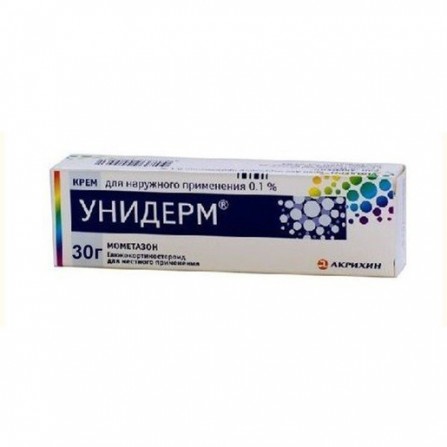Uniderm cream for drug use 30g
Condition: New product
1000 Items
Rating:
Be the first to write a review!

More info
Release form
Cream
Composition
1 g mometasone furoate 1 mg. Excipients: hexylene glycol, glyceryl monostearate 40-55, cetostearyl alcohol, macrogol 20 cetyl stearate, white wax, titanium dioxide, aluminum starch, octenylsuccinate, phosphoric acid, diluted, white petroleum, purified water.
Pharmacological effect
GKS for external use. It has anti-inflammatory, antipruritic, antiexudative action. Mometasone (like other GCS) induces the release of proteins that inhibit phospholipase A2 and commonly known as lipocortins, which control the biosynthesis of inflammatory mediators such as prostaglandins and leukotrienes, by inhibiting the release of their common precursor, arachidonic acid.
Pharmacokinetics
With external use of the cream Uniderm absorption is negligible. 8 h after application to intact skin (without an occlusive dressing), about 0.4% of the active substance is detected in the systemic circulation.
Indications
- inflammatory symptoms and itching in dermatoses, susceptible to treatment of corticosteroids.
Contraindications
- pink acne - perioral dermatitis - bacterial, viral (caused by Herpes simplex types 1 and 2, Varicella zoster) or fungal infections of the skin - tuberculosis - syphilis - post-vaccination reactions - children under 6 months old - pregnancy (treatment of large areas of skin, long-term treatment) - lactation period (use in high doses or / and for a long time) - hypersensitivity to the drug components or to GCS. The drug should be used with caution on the skin of the face and in the area of skin folds, with occlusive dressings, as well as when applied to large areas of skin and / or long-term treatment (especially in children older than 6 months).
Use during pregnancy and lactation
The safety of using Uniderm cream during pregnancy and lactation has not been studied. GCS penetrate the placental barrier. During pregnancy, avoid long-term treatment and use of the drug in high doses due to the threat of a negative impact on the development of the fetus. GCS is excreted in breast milk. In the case when the use of the drug in high doses and / or for a long time is expected, breastfeeding should be stopped.
Dosage and administration
The drug is used externally. A thin layer of Uniderm cream is applied to the affected skin 1 time / day. The duration of the course of treatment is determined by its effectiveness, as well as by the tolerance of the patient, the presence and severity of side effects.
Side effects
Dermatological reactions: rarely - irritation and dry skin, burning sensation, itching, folliculitis, hypertrichosis, acne, hypopigmentation, perioral dermatitis, skin maceration, the addition of a secondary infection, signs of skin atrophy, stria, streak; less than 1% - the formation of papules, pustules. Allergic reactions: allergic contact dermatitis. Others: when using Uniderm cream for a long time and / or for treating large areas of skin, or using occlusive dressings, especially in children and adolescents, side effects may occur that are characteristic of systemic GCS, including adrenal insufficiency and Cushing's syndrome.
Overdose
Symptoms: depression of the hypothalamic-pituitary-adrenal system, including secondary adrenal insufficiency. Treatment: symptomatic, if necessary - correction of electrolyte imbalance, drug withdrawal (with long-term therapy - gradual cancellation).
Interaction with other drugs
There is no data on the interaction of Uniderm cream with other drugs.
special instructions
When applied to large areas of the skin for a long time, especially when applying occlusive dressings, the development of systemic action of the SCS is possible. Given this, patients should be monitored to identify symptoms of suppression of the function of the hypothalamic-pituitary-adrenal system and the development of Cushing's syndrome. Avoid contact with eyes Uniderm. Propylene glycol, which is part of the drug, can cause irritation at the site of application. In such cases, you should stop using the cream Uniderm and prescribe the appropriate treatment. It should be borne in mind that GCS can alter the manifestations of certain skin diseases, which may make diagnosis difficult. In addition, the use of corticosteroids may cause delayed wound healing. With long-term GCS therapy, the sudden cessation of therapy can lead to the development of rebound syndrome,manifested in the form of dermatitis with intense reddening of the skin and burning sensation. Therefore, after a long course of treatment, the removal of the drug Uniderm should be made gradually, for example, switching to an intermittent treatment before it is completely stopped. Use in Pediatrics The safety and efficacy of Uniderm with topical administration in children older than 6 months for a period longer than 6 weeks has not been studied. Due to the fact that in children, the ratio of surface area and body weight is greater than in adults, children are at greater risk of suppressing the function of the hypothalamic-pituitary-adrenal system and the development of Cushing syndrome when using any GCS for external and local use. Long-term treatment of children with GKS can lead to impaired growth and development. Children should receive a minimum dose of the drug, sufficient to achieve the effect. In children aged 6 months to 2 years, the course of treatment should not exceed 5 days.





